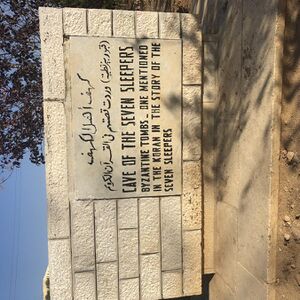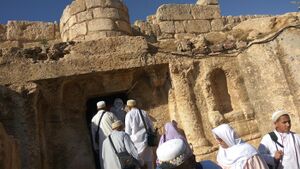History:Cave of Seven Sleepers
The Cave of the Seven Sleepers (Arabic: كهف الرقيم, Kahf ar-Raqīm) is a historical and religious site in al-Rajib, a village to the east of Amman.[1] It is claimed that this cave housed the Seven Sleepers (Arabic: اصحاب الكهف, aṣḥāb al kahf) - a group of young men who, according to Byzantine and Islamic sources, fled the religious persecution of Roman emperor Decius.[2] Legend has it that these men hid in a cave around 250 BC, emerging miraculously about 300 years later. Considerable debate remains concerning the exact location of this cave - various locations in Turkey including Afşin, Tarsus[disambiguation needed], and Mount Pion been suggested in addition to the al-Rajib site. The site is surrounded by the remains of two mosques and a large Byzantine cemetery. It is near the Sabah bus station and approximately a fifteen-minute bus ride from Amman's Wihdat Station.[3]
Origins of the Cave's Name
The English name of this site refers to the seven sleepers who sought refuge in the cave, despite that accounts differ widely concerning the number of sleepers. The canonical Islamic text refers to seven sleeper and a dog. The site's Arabic name, Arabic: كهف الرقيم, Kahf ar-Raqīm, is based on the triliteral root Arabic: ر-ق-م, denoting writing or calligraphy. It may refer to the village or mountain that the cave is located in. It also may refer to the book that recorded the names of the seven sleepers, as is suggested in Muhammad ibn Jarir al-Tabari's exegetical work Tafsir al-Tabari. The nearby village's modern name, al-Rajib, could be a corruption of the term al-Raqīm.[4]
Discovery and Excavation
In 1951, Jordanian journalist Taysir Thabyan discovered the Cave of Seven Sleepers. He preceded to publish its photo on the journal of the Syrian Military Police and inform the Jordanian Department of Antiquities.[5] The department assigned Jordanian archaeologist Rafiq al-Dajani the task of research and exploration in the cave.[6] They found eight smaller sealed tombs inside the main cave, with the bones preserved inside.[7]
Religious Lore
Islamic
Some argue that the Cave of Seven Sleepers is the location referred to in Surah al-Kahf of the Qur'an.[8] The surah is named after the Cave - al-Kahf - in honor of the alleged piety of the seven sleepers. [9] The site's connection with Islamic heritage led to the participation of various Islamic leagues in its exploration and excavation.
This cave was identified with Qur'anic record due to the name of nearby village al-Rajib, which is etymologically similar to the word al-Raqīm, mentioned in al-Kahf. Some also argue the site's correspondence with the Surat al-Kahf based on the finding of a dog's skull near the cave door.[10]
References
- ↑ "Seven Sleepers Cave - Turkish News" (in en). https://www.hurriyetdailynews.com/seven-sleepers-cave-49095.
- ↑ "Seven Sleepers of Ephesus". Encyclopædia Britannica, inc.. https://www.britannica.com/topic/Seven-Sleepers-of-Ephesus. Retrieved 13 June 2020.
- ↑ "Cave of the Seven Sleepers". Lonely Planet. https://www.lonelyplanet.com/jordan/amman/attractions/cave-of-the-seven-sleepers/a/poi-sig/1105549/361068. Retrieved 13 June 2020.
- ↑ "Cave of the Seven Sleepers" (in en). http://www.atlasobscura.com/places/yedi-uyurlar-magarasi-cave-of-the-seven-sleepers.
- ↑ بن عبدالله المغلوث, سامي. أطلس الأماكن في القرآن الكريم. العبيكان للنشر. p. 146.
- ↑ "لأول مرة: بالدليل صوت وصورة.. هنا رقد "فتية الكهف" وهذه قبورهم". https://www.alwatanvoice.com/arabic/news/2019/07/22/1261280.html. Retrieved 13 June 2020.
- ↑ "Cave of the Seven Sleepers". Lonely Planet. https://www.lonelyplanet.com/jordan/amman/attractions/cave-of-the-seven-sleepers/a/poi-sig/1105549/361068. Retrieved 13 June 2020.
- ↑ Patel, D. S.. "Jordan". Gale Credo Reference. https://search.credoreference.com/content/entry/galeislam/jordan/0?institutionId=4864. Retrieved 13 June 2020.
- ↑ Al-Qur'an. p. Surah 18.
- ↑ "لأول مرة: بالدليل صوت وصورة.. هنا رقد "فتية الكهف" وهذه قبورهم". https://www.alwatanvoice.com/arabic/news/2019/07/22/1261280.html. Retrieved 13 June 2020.



